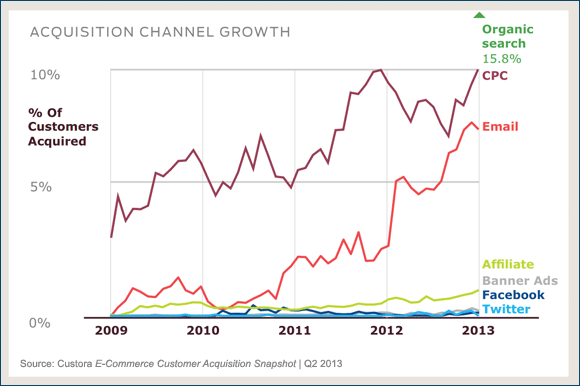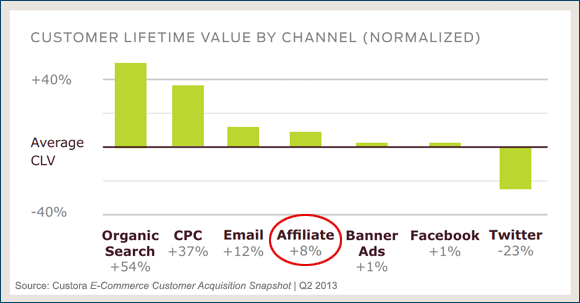In a new research devoted to e-commerce customer acquisition Custora has analyzed how people shop online when referred to e-tailers via different marketing channels.
Having studied “72 million customers from 86 U.S. retailers across 14 industries” (over the past four years), they have found out that the top [tweetherder]3 most effective customer acquisition channels are Organic Search (15.8%), CPC (9.82%), Email (6.84%)[/tweetherder]
I am pleased to see that Affiliate is also on the list, and that it is now landing twice as many customers as two years ago. However, its share in the overall percentage was quoted as minimal: growing from 0.34% in 2009 to nearly 1% in 2013 (see the exact breakdown below). It is unclear from the research whether all of the 86 merchants analyzed had affiliate programs, or how exactly are “referral” relationships were/are structured (Referral channel was concluded to yield 6%-7% of all customers acquired, showing a CLV 26.1% higher than average), and what channels have affiliates themselves been using to drive these customers.
Percentage of Customers Acquired (via Affiliates)
- 2009: 0.34%
- 2010: 0.44%
- 2011: 0.42%
- 2012: 0.75%
- 2013: 0.96%
Display, Facebook, and Twitter couldn’t compare to the above-quoted avenues of acquiring customers — neither in the percentage(s) of customers acquired over the past four years, nor as far as CLV goes.
Customer Lifetime Value (CLV) refers to the future profit a company expects to earn from a customer throughout his or her relationship with the business. [source]
Measuring CLV against the shopping metrics of an average customer, Custora found that customers who came through affiliates were 8% more valuable than average, being more likely to shop with the retailer more than an average customer. SEO and PPC-referred customers (both via Google in this research) were the most valuable ones to e-tailers. However, unlike it was with the percentage of customers acquired metric (where Affiliate was beaten by Email nearly 7 to 1), on the CLV front the difference wasn’t as drastic (11.81% vs 7.53% higher than average):
Custora summarized:
Organic search still leads as the largest channel for online customer acquisition. But as more retailers move towards a “free-to-paid” subscriber model and rely on third parties to help drive visitors to their sites, email and affiliate channels have seen an explosion in growth over the past few years.
You may download the full report here.
I’d love to hear your thoughts (or better yet: observations) on both of the above-quoted metrics. Are your affiliates driving only about 1% of customers? And what about the customer lifetime value (if you’re measuring it by “channel”)?


Pingback: Marketing Day: July 5, 2013
“affiliate channels have seen an explosion in growth over the past few years” – probably because merchants are getting serious about this channel and spending resources on it 🙂
Imho, any channel can make it to “top 3” if the right amount of attention/budget is allocated for it. E.g. in our case affiliates drive more sales than email, probably because we spend more time/$ developing the affiliate channel.
Hi Geno,
Very interesting post and it’s always great to see some reliable stats like these. I think you highlighted the biggest issue with these figures in that it doesn’t detail how many advertisers have an affiliate programme. 1% just seems a bit low to me.
I didn’t have any luck with the link to the full report however, it seems to be broken?
Thanks!
Dave, sorry about the broken link. I’ve just fixed it.
1% seem “a bit low” to me too. In fact, all my experience shows that well-developed affiliate programs bring anywhere between 10% and 40% of customers. Kush seems to imply something along similar lines.